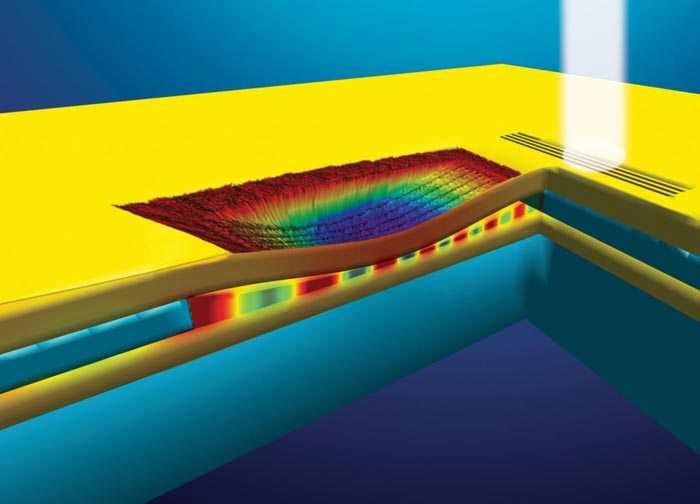Mind the gap: Nanoscale speed bump could regulate plasmons for high-speed data flow

The plasmonic phase modulator is an inverted, nanoscale speed bump. Gold strands are stretched side by side across a gap just 270 nanometers above the gold surface below them. Incoming plasmons travel though this air gap between the bridges and the bottom gold layer. Lowering the Credit: Dennis/Rutgers and Dill/NIST
Developed by a team of government and university researchers, including physicists from the National Institute of Standards and Technology (NIST), the innovation harnesses tiny electron waves called plasmons. It's a step towards enabling computers to process information hundreds of times faster than today's machines.
Computers currently shuttle information around using electricity traveling down nanoscale metal wires. Although inexpensive and easy to miniaturize, metal wires are limited in terms of speed due to the resistance in the metal itself.
Fiber optics use light to move information about 10,000 times faster, but these and other nonmetallic waveguides are constrained by pesky physical laws that require critical dimensions to be at least half the wavelength of the light in size; still small, but many times larger than the dimensions of current commercial nanoscale electronics.
Plasmonics combines the small size and manufacturability of electronics with the high speeds of optics. When light waves interact with electrons on a metal's surface, strong fields with dimensions far smaller than the wavelength of the original light can be created–plasmons. Unlike light, these plasmons are free to travel down nanoscale wires or gaps in metals.
The team, which included researchers from Rutgers, the University of Colorado at Colorado Springs, and Argonne National Laboratory, fabricated their device using commercial nanofabrication equipment at the NIST NanoFab. Small enough to serve in existing and future computer architectures, this technology may also enable electrically tunable and switchable thin optical components.
Their findings were published in Nature Photonics.
The plasmonic phase modulator is effectively an inverted, nanoscale speed bump. Eleven gold strands are stretched side by side like footbridges across a 23-micrometer gap just 270 nanometers above the gold surface below them. Incoming plasmons, created by laser light at one end of the array, travel though this air gap between the bridges and the bottom gold layer.
When a control voltage is applied, electrostatic attraction bends the gold strands downwards into a U shape. At a maximum voltage–close to the voltages used in today's computer chips–the gap narrows, slowing the plasmons. As the plasmons slow, their wavelength becomes shorter, allowing more than an extra half of a plasmonic wave to fit under the bridge. Because it's exactly out of phase with the original wave, this additional half wavelength can be used to selectively cancel the wave, making the bridge an optical switch.
At 23 micrometers, the prototype is relatively large, but according to NIST researcher Vladimir Aksyuk, their calculations show that the device could be shortened by a factor of 10, scaling the device's footprint down by a factor of 100. According to these calculations, the modulation range can be maintained without increase in the optical loss, as the length and the size of the gap are reduced.
“With these prototypes, we showed that nanomechanical phase tuning is efficient,” says Aksyuk. “This effect can be generalized to other tunable plasmonic devices that need to be made smaller. And as they get smaller, you can put more of them on the same chip, bringing them closer to practical realization.”
###
B.S. Dennis, M.I. Haftel, D.A. Czaplewski, D. Lopez, G. Blumberg and V.A. Aksyuk. Compact nano-mechanical plasmonic phase modulators. Nature Photonics. Available online March 30. 2015.
Media Contact
All latest news from the category: Physics and Astronomy
This area deals with the fundamental laws and building blocks of nature and how they interact, the properties and the behavior of matter, and research into space and time and their structures.
innovations-report provides in-depth reports and articles on subjects such as astrophysics, laser technologies, nuclear, quantum, particle and solid-state physics, nanotechnologies, planetary research and findings (Mars, Venus) and developments related to the Hubble Telescope.
Newest articles

Bringing bio-inspired robots to life
Nebraska researcher Eric Markvicka gets NSF CAREER Award to pursue manufacture of novel materials for soft robotics and stretchable electronics. Engineers are increasingly eager to develop robots that mimic the…

Bella moths use poison to attract mates
Scientists are closer to finding out how. Pyrrolizidine alkaloids are as bitter and toxic as they are hard to pronounce. They’re produced by several different types of plants and are…

AI tool creates ‘synthetic’ images of cells
…for enhanced microscopy analysis. Observing individual cells through microscopes can reveal a range of important cell biological phenomena that frequently play a role in human diseases, but the process of…





















